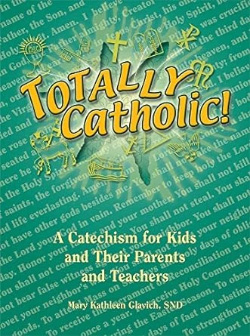
I’m rediscovering things about the Mass, in particular the role of the crucifix and the Sign of the Cross. This is because currently I’m writing a book about the sacraments. Here are some facts that might interest you.
A crucifix is there at each celebration of the Eucharist. This is because at Mass the sacrifice of Jesus on Calvary is re-presented for us. We remember what he did for us and offer him to the Father along with ourselves. By the way, technically a crucifix is a cross with the body of Jesus while a cross is bare.
The Coesfeld Cross

The crucifix in our Provincial House chapel is called the Coesfeld Cross. The original one is in Coesfeld, Germany, in St. Lambert’s church where the first Sisters of Notre Dame taught. It is huge and has a unique forked shape. It was carved in the 14th century. Relics have been inserted, including one of the true cross. Pilgrimages are made to it. Today replicas of this cross are carried in procession. Our convents and Sisters were given miniature Coesfeld crosses.

At Mass the crucifix leads the entrance procession and the recessional. I’m one of a handful of Sisters who can carry our crucifix and place it in its stand. It is large, so care is needed to avoid hitting the ceiling. It is also top heavy, so balancing it is a feat. Other challenges occur at the end of Mass. First, you have to remember to retrieve it for the recessional. Then you must turn it to face outward. And finally you need to carry it to the front of the altar before the priest gets there.
The Sign of the Cross
The Sign of the Cross is one of the first prayers Catholics learn. It is a sacramental. We begin and end prayers with it. To teach my first graders to touch the left shoulder first, I had to make the Sign in reverse because they mimic you. Or I had to turn my back to them and make it the correct way. (Eastern Catholics touch the right shoulder first, then the left.) At the conclusion some people make a cross with their thumb and forefinger and kiss their thumb.
On entering the church or chapel for Mass, we bless ourselves by making the Sign of the Cross with holy water, a reminder of our baptism. Blessings are also given to others by making the Sign of the Cross on their foreheads.
Mass begins with everyone making the Sign of the Cross, the sign of our salvation. If the Mass includes a blessing with holy water, we make the Sign of the Cross when the water is sprinkled our way. Before the Gospel is read, we sign crosses on our forehead, lips, and chest. I was taught to say at that time, “Jesus, be in my mind. Jesus be on my lips. Jesus be in my heart.” Were you?
Mass concludes with the priest blessing the congregation with the Sign of the Cross. A bishop will make the Sign three times. And we make it over ourselves.

The Sign of the Cross appears in all the other sacraments too. For example, in confession we being with the Sign of the Cross and the priest makes it over us when giving absolution.
Because we are so used to this sign, it’s easy to get in the habit of making it quickly and thoughtlessly…like I told my students, as though we were swatting flies. When you think about it, this Sign deserves to be made reverently and intentionally. It is an admission of the foundation of our faith: the Holy Trinity. It also makes holy whatever we do after it.
Crosses
Christians wear crosses as a sign of their faith in Jesus, the Savior. This past year I came across an unusual one. It is called the Pardon Cross. One the back are the words “Father, forgive them” and Jesus’s words to St. Margaret Mary: “Behold this heart which has so loved me.” At the bottom is a fancy M for Mary who stood at the foot of the cross.


The song “The Power of the Cross” is new to me. Here it is sung here by a virtual choir of young people:
• Who taught you to make the Sign of the Cross?
• Do you have a cross that has special meaning for you?










4 Responses
Dear Sr Kathleen,
I enjoy your website very much. I found a beautiful crucifix when I was 4 or 5 years while making mud pies outside my grandmother’s home. I ran into the house to show my Mother. My Mother told me to, “go wash it, you can keep it.” I’m 83 in two months, I still have my beautiful crucifix.
I make the sign of the cross after receiving the host in thankfulness to an aunt that took me to her church often as a child. I remember her making the sign of the cross after receiving the Eucharist, I notice some people still do. Thank you again for your informative and helpful website and your wonderful books. God Bless you.
Dear Kay, finding that cross was indeed a blessing … and a sign of blessings to come, right? And you are a blessing to me.
I imagine my mother taught me. I wear a cross, my sister gave me. My two sisters had the same cross that we all wore. It’s a Celtic Cross because of our Irish heritage. Thanks for your sharing your knowledge; I enjoyed the song.
Thanks for reading my blog, Rita. You make writing it worthwhile!